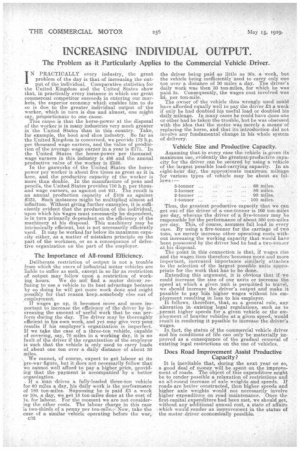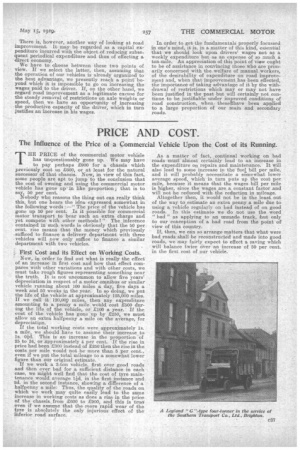INCREASING INDIVIDUAL OUTPUT.
Page 14

Page 15

If you've noticed an error in this article please click here to report it so we can fix it.
The Problem as it ,Particularly Applies to the Commercial Vehicle Driver.
IN PRACTICALLY every industry, the great problem of the day is that of increasing the output of the individual. Comparative statistics for the United Kingdom and the United States show that, in practically every instance in which our great commercial competitor succeeds in entering our markets, the superior economy which enables him to do so is due to the greater individual output of the worker, which in turn is due and almost, one might say, proportionate to one cause.
This cause • is that the horse-power at the disposal of the worker is in many industries very much greater in the United States than in this country. Take, for example, the hoot and shoe industry. So far as the United Kingdom is concerned, we provide 172 h.p. per thousand wage earners, and the value of production of the average wage earner in a year is £171. 'In the United States the horse-power per thousand wage earners in this industry is 486 and the annual productive value of the worker is 2526.
In the gasworks of -the United States the horsepower per worker is about five times as great as it is. here, and the productive capacity of the worker is more than double. In the manufacture of pens and pencils, the United States provides 710 h.p. per thousand wage earners, as against out 241. The result is an annual production capacity of 419 as against 2131. Such instances might be multiplied almost ad infinittim. Without giving further examples, it is sufficiently evident that the production of the individual, upon which his *ages must necessarily be dependent, is in turn primarily dependent on the efficiency.of the machinery at his disposal. This machinery may be intrinsically efficient, lut is net necessarily efficiently. used. It may be worked far below its maximum capacity either, as a matter Of mistaken principle on the part of the workmen, or as a consequence of defective organization on the part of the employer.
The Importance of All-round Efficiency.
Deliberate restriction of output is not a trouble from which the users of industrial motor vehicles are
liable to suffer as such, eXeept in so far as restriction of output may follow upon a restriction of working. hours. We do not find a motor driver refusing to use a vehicle to its best advantage because by so doing he will get more work done and might possibly for that reason keep -somebody else out of employment. Ti wages .go up, it becomeS mere and more important to increase the efficiency of the driver by in-creasing the amount of useful work that he can perform during the day. The driver may be thoroughly efficient in his own work, and yet may give very poor.
results if his employer's organization is imperfect. If we take the case of a three-ton vehiele, capable • of covering, say, 70 miles in a working clay, it is no fault of the driver if the organization of the employer is such that the vehicle is only used to carry loads of about •one ton over a daily distance of about • 30 miles.
• We cannot, of course, expect to get labour at its pre-war-figure, but it does not necessarily follow that
we .cannot well afford to pay a higher price, providing that the payment is accompanied by a better organization.
. If a man drives a fully-loaded three-ton vehicle for 60 miles a 'day, his daily work is the performarece of 180 ton-miles. Supposing he is paid 23 a week or 10s. a day, We get 18 ton-miles done at the cost of is. for labour. For the moment we are not considering the other costs. The labour charge in this case is two-thirds of a penny per ton-mile. 'Now, take the case of a similar vehicle operating before the war, e.26 the driver being paid as little as 30s. a week, but the vehicle being inefficiently used to carry only one ton over a distance of 30 miles a day. The driver's daily work was then 30 ton-miles, for which be was paid 5s. Consequently, the wages cost involved was 2d. per ton-mile.
The owner of' the vehicle thus wrongly used could have afforded equally well to pay the driver 23 a week if only he had doubled his useful load or doubled his daily mileage. In many cases he could have done one or other had he taken the trouble, but he was obsessed, with the idea thaethe motor was merely a meansof replacing the horse, and that its introduction did not involve any fundamental change in his whole system of delivery.
Vehicle Size and Productive Capacity.
Assuming that-in every ease the. vehicle is given its maximum use, evidently the greatest-productive capacity for the driver can be secured by using a vehicle of the largest possible load-carrying capacity. In an eight-hour day, the approximate maximum mileage 'for various types of vehicle may be about as fol
lows :—
Thus, the greatest productive capacity that we can get out-of the driver, of a one-tonner is 100 ton-miles per day, whereas the driver of a five-tonner may be responsible for the performance of about 390 ton-miles per day. This, of course, assumes fall load in every. ease. By using a five-tanner for the carriage of two tons, we merely increase other -operating costs without increasing the working capacity that .would have been possessed by the driver had he had a two-toneer at his disposal.
The point in this connection is that, if wages rise and the wages item therefore becomes more and more important, increased importance similarly attaches to the selection of the largest possible units appropriate for the work that has to be done.
Extending this argument, it is obvious that if we could increase the size -of our units or increase the speed at which a given unit. is permitted to travel, we should increase the driver's output and make it possible to pay -hula higher wages without his employment resulting in loss to his employer.
It follows, therefore, that as a general rule, any. alteration inexisting legal regulations, such as to _permit higher speeds for a given vehicle or the employment of heavier vehicles at a given speed, would result in rendering it possible to increase the driver's wages.
In fact, the status of the commercial vehicle driver and his conditions of life can only be materially improved as a consequence of the gradual removal of existing legal restrictions on the use of vehicles.
Does Road Improvement Assist Productive Capacity?
It is inevitable that, during the next year or so, a good deal of money will be spent on the improvement of roads. The object of this expenditure might be to render' possible a relaxation of restrictions and an all-round increase of axle weights and speeds. If roads are better constructed, then higher speeds and higher axle weights would not necessarily involve higher expenditure on road maintenance. Once the first-capital expenditure had been met, we should get, without any additional annual cost, a state of affairs which would render an improvement in the status of the motor .driver economically possible.
There is, however, another way of looking at road improvement. It may be regarded as a capital expenditure incurred with the object of reducing subsequent periodical expenditure and thus of effecting a direct economy.
We have to choose between these two points of -view. If we select the latter, then assuming that the operation of our vehicles is already organized to the best advantage, we presently reach a, pointbeyond which it is impassible to go on increasing the wages paid to the driver. If, on the other hand, we regard road improvement as a legitimate excuse for the steady removal of restrictions on axle weights or speed, then we have an opportunity of increasing the productive capacity of the driver, which in turn justifies an increase in his wages.
In order to get the fundamentals properly focussed in one's mind, it is, in a matter of this kind, essential that we should look upon drivers' wages not as a weekly expenditure but as an expense of so much a ton-mile.. An appreciation of this point of view ought to be of assistance in convincing those who are primarily concerned with the welfare of manual workers, of the desirability of expenditure on road improvement and, when that improvement has been effected, the importance of taking advantage of it by the withalrawal of restrictions which may or may not have been justified in the past but will certainly not continue to be justifiable under improved conditions of road construction, when, thesenave been applied to a large proportion of our main and secondary roads.






















